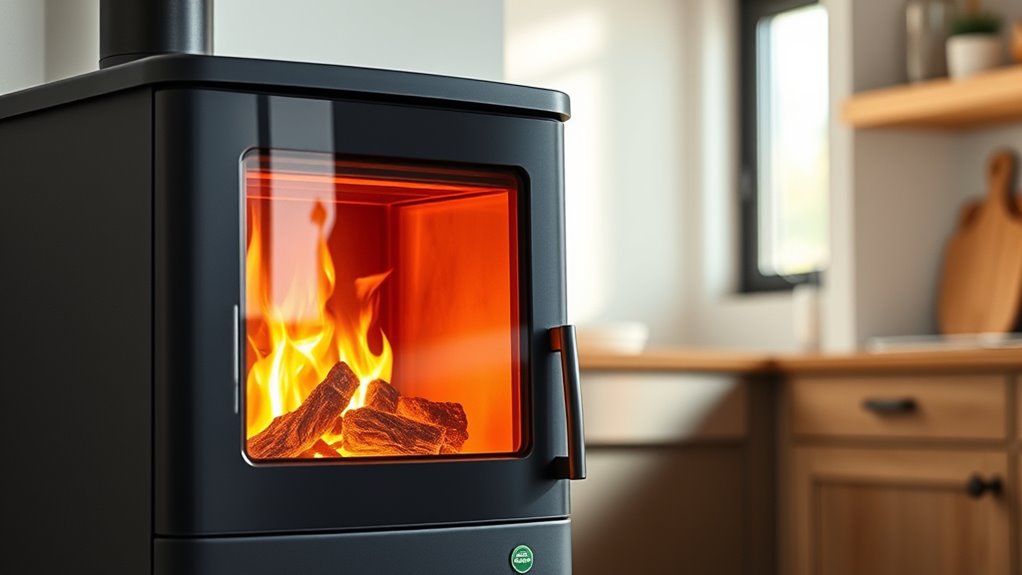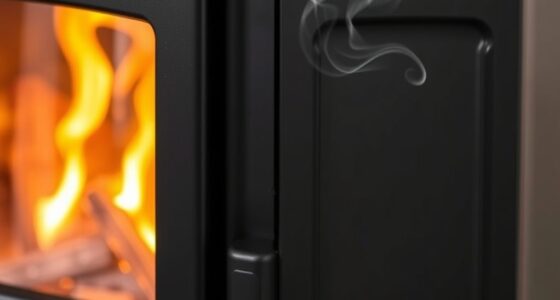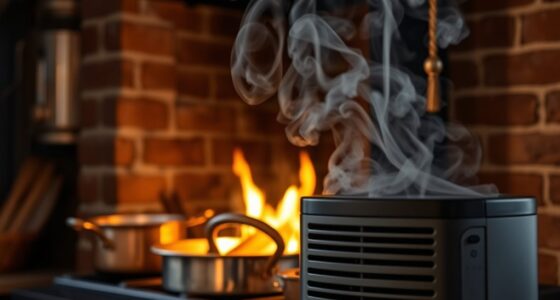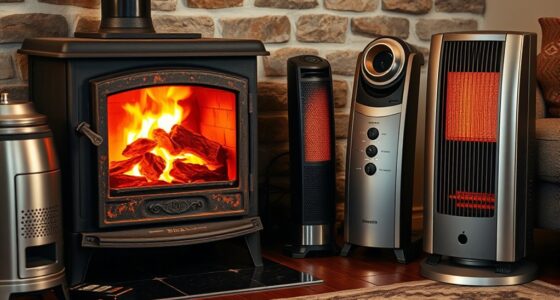An EPA-certified wood stove meets strict emission and efficiency standards set by the Environmental Protection Agency. This means it burns wood more cleanly, producing fewer pollutants and improving indoor air quality. The certification label confirms the stove has passed rigorous testing for emissions and fuel use. Choosing an EPA-certified model helps you stay compliant with regulations, qualify for rebates, and enjoy safer, more efficient heating. Keep exploring to learn how certification benefits both you and the environment.
Key Takeaways
- EPA-certified wood stoves meet strict emission limits, producing no more than 2.5 grams of smoke per hour since 2020.
- Certification verifies the stove’s efficiency, safety, and compliance with environmental standards.
- Look for a white EPA label on the stove or verify certification through the EPA’s online database.
- Certified stoves use advanced combustion technologies like catalytic converters to reduce pollutants.
- Using an EPA-certified stove helps qualify for rebates, incentives, and ensures healthier indoor air quality.
Understanding the EPA and Its Role in Wood Stove Standards

Understanding the EPA and its role in wood stove standards is key to making informed choices about your heating options. The EPA, established in 1970, is responsible for protecting environmental and public health by regulating pollutants and emissions. In the 1990s, the agency set specific standards for wood stoves, gradually tightening limits—from 7.5 grams/hour in 2004 to less than 2.5 grams/hour by 2020. An EPA-certified wood stove meets these strict standards through rigorous testing and labeling, ensuring it emits considerably fewer pollutants than older, uncertified models. When you choose an EPA-certified wood stove, you’re opting for a product that’s more efficient and environmentally friendly, helping reduce harmful particulate matter and air pollution. This certification guarantees that your heating appliance adheres to the latest, most stringent emission standards.
What Defines an EPA-Certified Stove?

An EPA-certified stove meets strict standards for emissions and efficiency set by the EPA. You can verify a stove’s certification through the official database or by checking for the label on the unit. Understanding these standards helps you choose a cleaner, more environmentally friendly heating option. Additionally, selecting an EPA-certified stove supports responsible consumption and promotes sustainability efforts. Regular maintenance and proper operation of EPA-certified stoves further ensure they perform efficiently and remain compliant with environmental standards. Being aware of wood stove types can also help you make informed decisions about installation and use, and understanding the performance benefits of certified models can lead to better long-term satisfaction. Properly operating and maintaining these stoves maximizes their emission reduction capabilities and ensures continued compliance over time.
Certification Standards Explained
EPA-certified wood stoves must meet strict emissions and efficiency standards to earn their label. These certification standards require the stoves to produce no more than 2.5 grams of smoke per hour since 2020, ensuring cleaner burning. During testing, your stove must demonstrate high efficiency, converting at least 75% of the fuel into heat, which minimizes waste and pollution. The process involves rigorous evaluation of emissions and fuel use, often using advanced features like catalytic converters or secondary combustion tubes to cut down pollutants further. When your stove passes these tests, it receives the EPA label—usually a white sticker—that confirms it meets all certification standards. This ensures your stove is both environmentally friendly and highly efficient. Additionally, understanding Gold IRA can help diversify your investment portfolio and provide long-term financial security. Knowing the specific emission limits and efficiency requirements helps consumers select stoves that are truly environmentally safe and cost-effective.
Compliance Verification Methods
To confirm that a wood stove is EPA-certified, look for the white EPA label affixed to the back of the unit, which indicates it has passed rigorous emissions and efficiency tests. This label is your first compliance verification method, confirming the stove meets EPA standards. You can also verify certification through the EPA’s online database, ensuring the stove’s current compliance status. All certified stoves must emit no more than 4.5 grams of particulate matter per hour, with recent models reducing this to 2.0 grams. Certification involves testing for particulate matter, carbon monoxide, and other pollutants, demonstrating strict adherence to environmental standards. Additionally, understanding emissions testing procedures can help consumers better interpret certification results and ensure environmental safety. Proper documentation and clear labeling are essential components of EPA certification, providing confidence in the stove’s environmental performance. Staying informed about regulatory standards can further help consumers make environmentally responsible choices, and awareness of performance standards can guide consumers in selecting efficient heating options. Recognizing certification labels on products can also facilitate quick identification of compliant units.
Recognizing EPA Certification on Your Stove
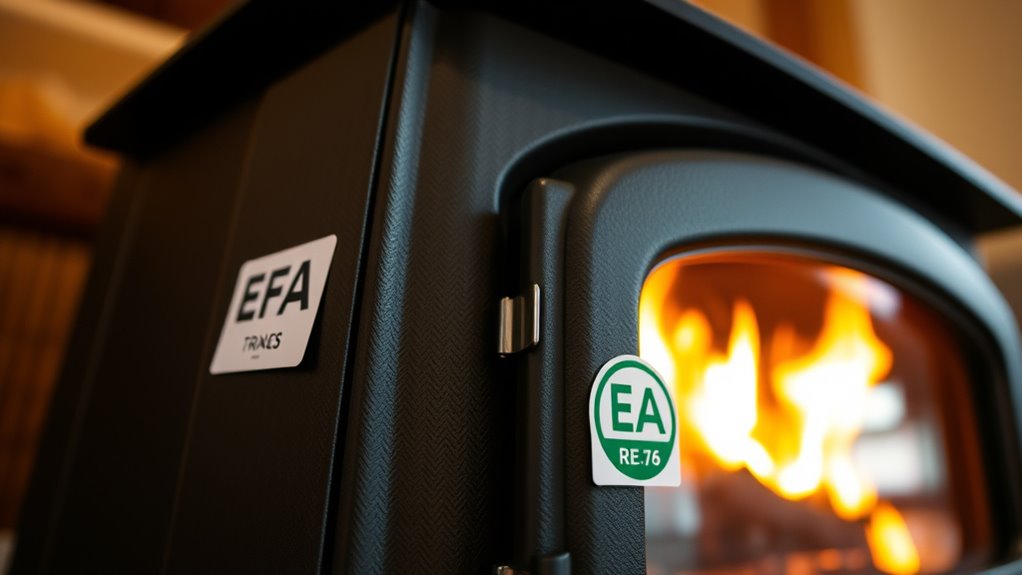
You can easily identify if your wood or pellet stove meets EPA standards by looking for a white label on the back that indicates certification. Recognizing EPA certification on your stove is essential for ensuring it’s a new EPA-certified model designed for high efficiency and low particle emissions. These labels confirm that the stove has passed rigorous testing by the Environmental Protection Agency, meeting strict limits—often less than 4.5 grams per hour—on emissions released into the atmosphere. Certified stoves, including wood stoves and fireplaces, may also feature catalytic converters to reduce pollutants. In the United States, all current wood-burning appliances with EPA certification are designed to burn wood more cleanly, making them safer and more environmentally friendly. Proper stove maintenance also plays a crucial role in maintaining EPA standards and optimal performance. Regular cleaning and inspection help ensure the stove continues to meet emission standards and operates efficiently, which is vital for air quality. Additionally, choosing models with advanced combustion technology can further improve efficiency and reduce emissions, contributing to a healthier environment.
Environmental and Health Benefits of Using Certified Stoves
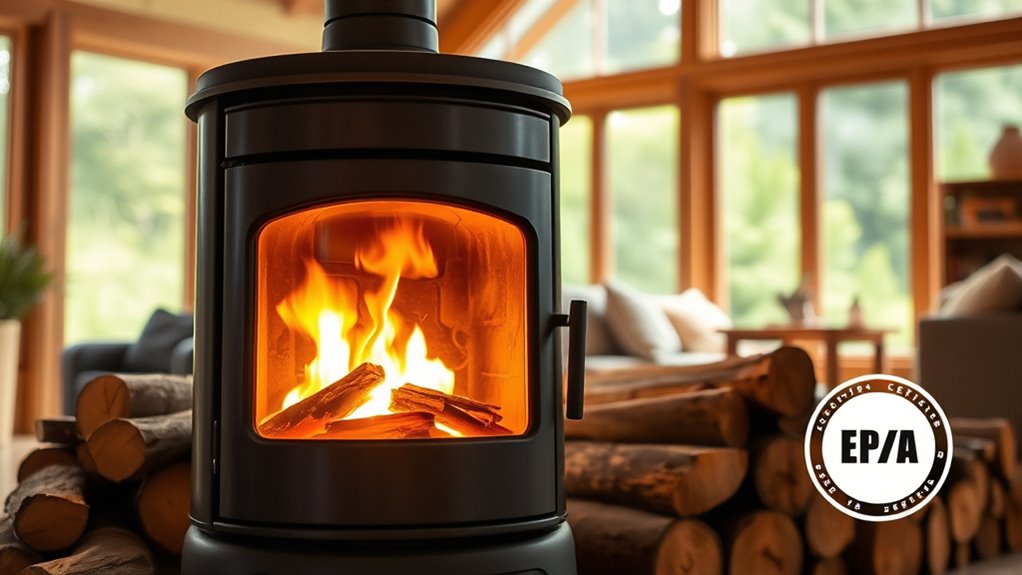
Using EPA-certified wood stoves helps cut down on air pollution, making your environment healthier and safer. They produce fewer fine particles, which means better indoor air quality and fewer respiratory issues. By choosing certified stoves, you’re also reducing emissions that harm the environment and contribute to climate change. Additionally, adopting cleaner stove technology aligns with efforts to reduce air quality concerns associated with traditional heating methods. Furthermore, EPA certification ensures that the stove meets strict standards for environmental impact, promoting sustainability and cleaner air. Implementing certified stoves can also lead to improved energy efficiency, resulting in lower fuel consumption and cost savings over time. Incorporating these environmentally friendly options supports broader sustainability initiatives and helps communities meet air quality standards. Using advanced combustion technology found in certified stoves can further enhance efficiency and reduce emissions, contributing to a healthier environment.
Reduced Air Pollution
EPA-certified wood stoves substantially reduce air pollution by emitting far fewer particulate matter and harmful pollutants than older models. These stoves are designed to emit no more than 4.5 grams of particulate matter per hour, a significant drop from uncertified models that can emit 15-30 grams/hour. By burning dry, seasoned wood, you help produce fewer fine particles, which improves air quality and lowers health risks linked to particulate inhalation. The use of EPA-certified stoves also decreases emissions of harmful pollutants like carbon monoxide and volatile organic compounds, benefiting both indoor and outdoor environments. Since stricter EPA standards, including limits of 2.5 grams/hour, came into effect, these stoves contribute less to smog formation and respiratory issues. Adopting EPA-certified wood stoves helps reduce local air pollution, creating healthier communities. Emission standards play a crucial role in ensuring these environmental benefits. Additionally, advanced combustion technology in certified stoves enhances combustion efficiency, further reducing emissions and increasing heat output. Implementing air quality regulations ensures ongoing improvements in emission reductions and environmental health.
Safer Indoor Air
Because they employ advanced combustion technology like catalytic converters, EPA-certified wood stoves burn more cleanly, considerably reducing indoor air pollutants. This leads to lower emissions of harmful fine particles and toxic gases, making your home safer. Using certified stoves helps minimize exposure to particulate matter and carbon monoxide, which are linked to respiratory and cardiovascular health issues. Proper maintenance assures these stoves continue to operate efficiently, further decreasing the presence of smoke and dangerous pollutants. Certification standards guarantee that the stove produces fewer hazardous emissions, creating a healthier indoor environment for you and your family. With cleaner burning, you can enjoy the warmth of a wood fire without sacrificing indoor air quality or your health.
Lower Emissions Levels
Lower emissions levels from EPA-certified wood stoves provide significant environmental and health benefits. These stoves emit no more than 4.5 grams of smoke per hour, drastically cutting particulate matter compared to older models that release 15-30 grams/hour. They produce fewer fine particles—often less than 2.5 grams/hour—helping improve air quality and reduce respiratory risks. Certification guarantees complete combustion, lowering hazardous pollutants like carbon monoxide and unburned hydrocarbons. Since 2004, standards have tightened, decreasing allowable emissions from 7.5 to 2.5 grams/hour by 2018. Using certified stoves helps lower local pollution, protecting vulnerable groups like children, the elderly, and those with respiratory issues.
| Emissions Standard | Particulate Matter (grams/hour) |
|---|---|
| 2004 Standard | ≤ 7.5 |
| 2018 Standard | ≤ 2.5 |
| Typical Older Model | 15-30 |
| Certified Stove | ≤ 4.5 |
| Fine Particles | Often < 2.5 |
Key Factors to Consider When Selecting an EPA-Certified Appliance
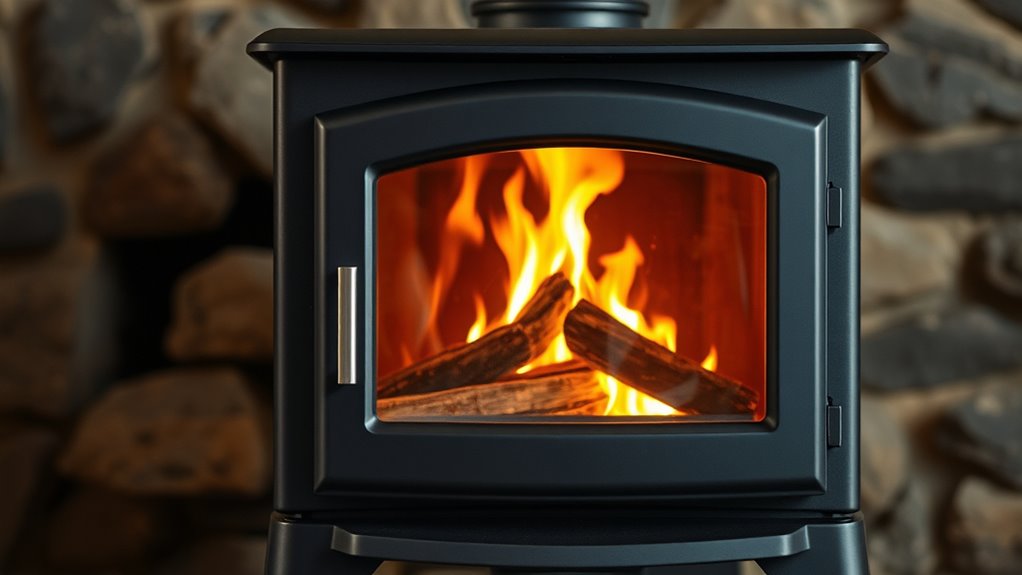
When choosing an EPA-certified wood stove, it’s essential to confirm its certification status and guarantee it meets your specific heating needs. Look for the white EPA label on the back of the unit or check the EPA’s online database to verify certification. Pay attention to the stove’s thermal efficiency rating; it should meet or exceed 75% to qualify for federal biomass tax credits. Evaluate the emission levels, aiming for models that emit less than 2.5 grams per hour to ensure compliance and reduce pollution. Consider the size, BTU output, brand reputation, and material quality to guarantee the stove fits your space and provides reliable heating. Keep in mind that all EPA-certified models have undergone rigorous testing for safety, emissions, and efficiency standards.
The Technology Behind EPA-Compliant Wood and Pellet Stoves

EPA-compliant wood and pellet stoves incorporate advanced combustion technologies that markedly reduce emissions and improve efficiency. You’ll find features like catalytic converters and secondary air tubes designed to burn smoke more completely. Catalytic stoves use palladium-based converters that lower combustion temperatures and re-ignite gases, resulting in cleaner burning and less pollution. Many models include secondary air intakes that mix with exhaust gases, encouraging the re-ignition of unburned particles before they exit the chimney. These technologies enable the stoves to operate effectively with dry, seasoned wood, maximizing combustion efficiency and minimizing particulate matter. Since EPA emission limits are very strict—down to 2.0 grams per hour—they push manufacturers to integrate pollution-reducing features. These innovations ensure your stove burns cleaner, more efficiently, and produces fewer emissions.
Common Misconceptions About EPA Regulations and Wood Burning
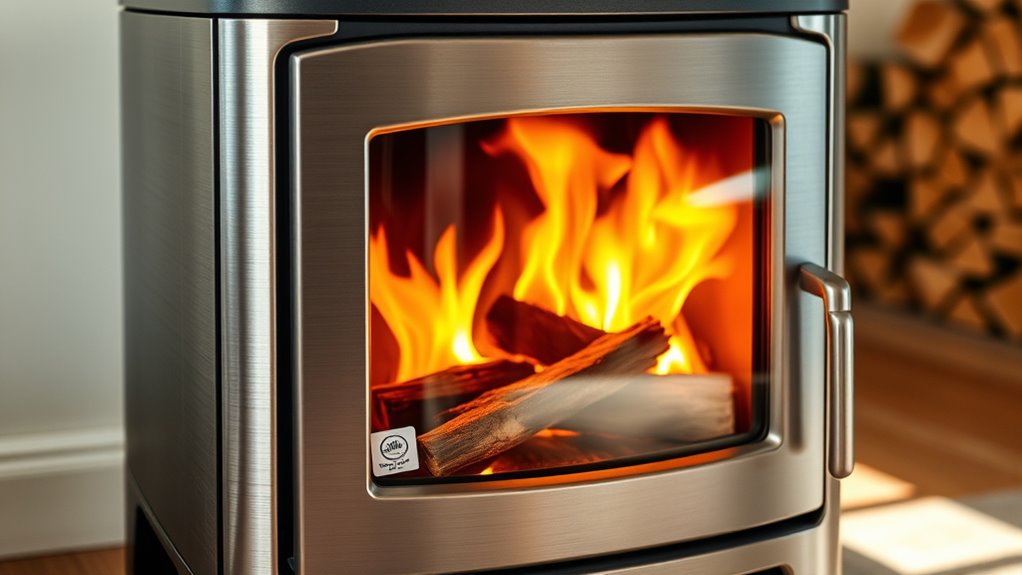
Many people assume that EPA regulations ban all wood burning, but in reality, certified stoves are widely available and allowed in most areas, including Montréal. These appliances meet strict pollution standards, and older, non-EPA models emit more smoke and pollutants, yet some believe they’re better because they burn wetter wood. Another misconception is that decorative fireplaces are banned everywhere, but they’re permitted in many places, except certain municipalities like Montréal. Some also think EPA standards limit stove efficiency, but in fact, certified stoves often perform better while drastically reducing emissions. Many assume these regulations are overly strict and unnecessary, but they’re based on scientific data designed to protect air quality and public health from harmful fine particles.
Comparing EPA-Certified and Non-Certified Stoves
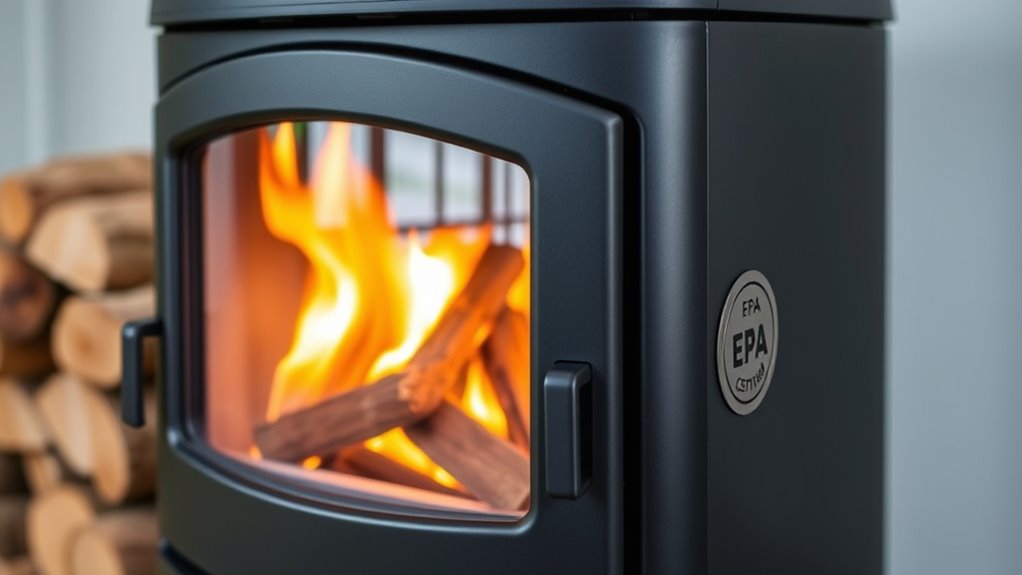
EPA-certified stoves are designed to burn cleaner and more efficiently than their non-certified counterparts. They emit no more than 4.5 grams of smoke per hour, while non-certified stoves can emit 15 to 30 grams/hour, considerably increasing pollution. Certified stoves are tested and labeled with a white EPA sticker on the back, confirming they meet strict emissions standards. In contrast, non-certified stoves often burn wetter wood and rely on simpler airflow controls, which produce more smoke and less complete combustion. Modern EPA-certified models incorporate advanced technologies like catalytic converters or secondary air tubes, ensuring cleaner, more efficient burns. Keep in mind, some decorative fireplaces with large glass areas are usually exempt from certification, but functional stoves are held to these rigorous standards.
Navigating Incentives and Support for EPA-Certified Heating Equipment

If you’re considering upgrading your heating equipment, taking advantage of available incentives can substantially reduce your costs. Many EPA-certified wood stoves qualify for a federal biomass tax credit of 30%, up to $2,000, available until 2032. To qualify, your stove must have at least 75% thermal efficiency and meet emission standards of 4.5 grams/hour or less. Always verify certification through the EPA’s database or label before purchasing. Incentives and rebates often require proof of certification and registration with local or federal authorities.
| Incentive Type | Requirements |
|---|---|
| Federal biomass tax credit | 75% thermal efficiency, emission standards of 4.5 g/hr |
| Local rebates | Proof of EPA certification |
Frequently Asked Questions
What Does EPA Certified Wood Stove Mean?
When you see an EPA-certified wood stove, it means the stove has passed strict tests for emissions and efficiency. You can trust it to produce fewer pollutants, with a limit of 4.5 grams of fine particles per hour. Look for the white EPA label or check online. Choosing this stove helps you stay compliant with environmental laws and keeps your air cleaner, safer, and more efficient.
What Year Did Wood Stoves Become EPA Certified?
You wonder when wood stoves actually became EPA certified, right? Well, it all started in the 1990s when the EPA began regulating emissions. The standards tightened over the years, with the 2004 limit at 7.5 grams per hour. By 2009, certification required stoves to emit just 4.5 grams, and since 2020, new stoves must be below 2.5 grams to be EPA-certified.
What Does EPA Exempt Mean?
When you hear “EPA exempt,” it means the wood stove hasn’t met EPA standards for emissions and safety, so it hasn’t been tested or approved. You might find these in older models or decorative fireplaces. While they can be sold or installed in some areas, they often produce more smoke and emissions. Using an EPA-exempt stove could lead to legal issues or environmental concerns, so check your local regulations before choosing one.
How Does the 26% Tax Credit for a Wood Stove Work?
So, you’re wondering how that 26% tax credit works, huh? Well, it’s like a government gift card for your wood stove—covering 26% of the purchase price. Just buy an EPA-certified stove, keep your receipts, and file them with your taxes. The max credit is $2,000, and it’s available until 2032. Basically, the government’s helping you stay warm while saving a chunk of change.
Conclusion
Choosing an EPA-certified wood stove means prioritizing cleaner air and healthier living for your family. While non-certified models might seem cheaper or easier, they often pollute more and harm your environment. By investing in certification, you embrace safety and sustainability, knowing you’re making a responsible choice. It’s a powerful step toward a warmer home that doesn’t come at the planet’s expense—because comfort and conscience should go hand in hand.

